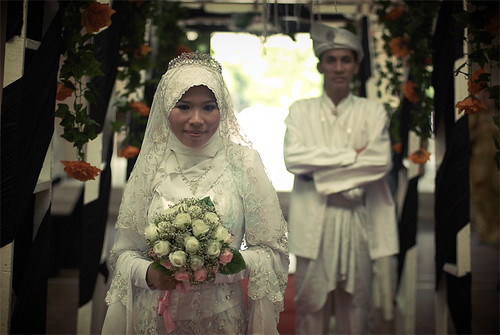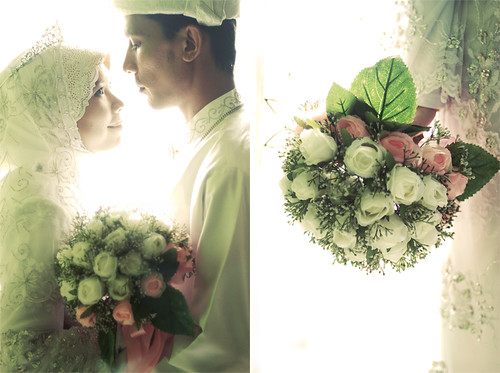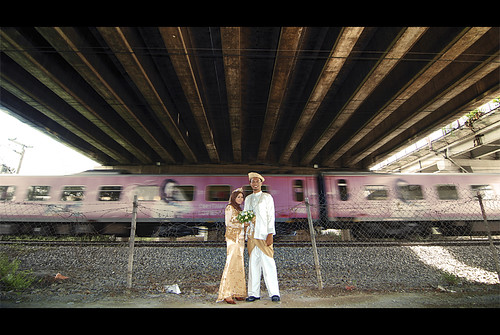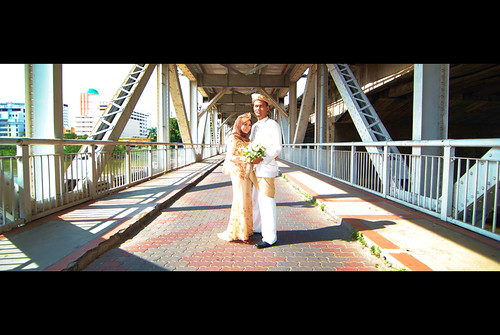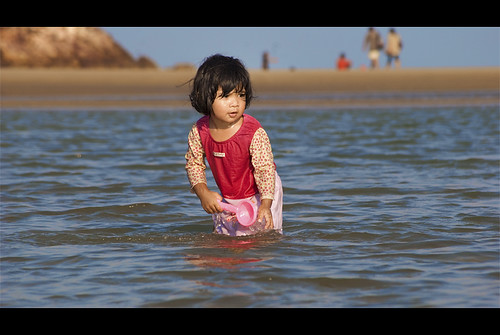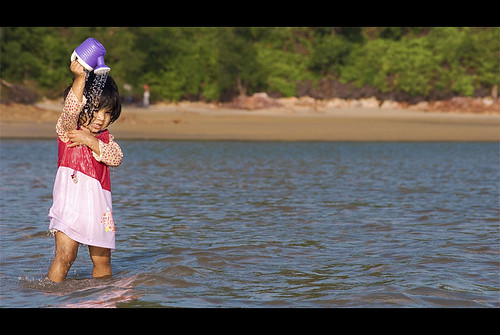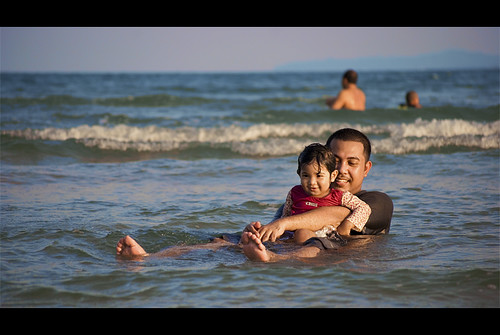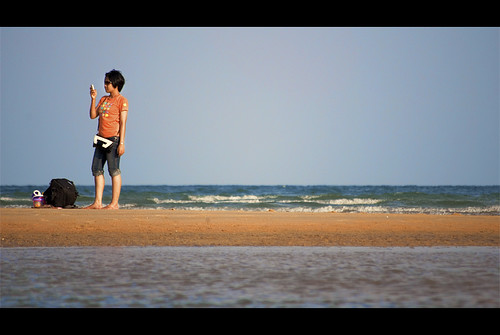Sunday, June 27, 2010
Wedding - Fad & Ain
Tuesday, June 22, 2010
Preparing The Portfolio
Again, to avoid another search, I pasted this article by the person credited below for my current pursue in creating a proper personal portfolio of mine. Still it's an ambition as I predicted it will take a lot of time for me to complete the portfolio (more of a re-do of what I currently have).
I'd been to several interviews recently and I discovered a revelation that my portfolio does not represent myself at all. All this while, I took this matter for granted now that it will cost me a sudden pressure if I were to return to the private sector.
Somehow, it sparks a new interest that I wasn't be able to explore before. Despite of my low self-esteem lately due to the current predicaments, however, I still do believe strongly in myself to explore it as I've done it before when I want to learn photography all by myself.
It's this kind of stuff that keeps me going and I ain't that useless anyway. Best of wishes to me!
Harold Linton is a professor of art and visual technology as well as chairman of the department of art and design at George Mason University, Fairfax, Va. He is the former assistant dean of architecture at Lawrence Technological University, Southfield, Mich. Linton is the author of Portfolio Design, a best-selling book in the field, and he is currently at work on its fourth edition. He is a popular speaker and workshop leader on portfolio design topics.
Great portfolios assist in our understanding of not only individual designers and their work but also their larger design vision and contributions in allowing us to see the familiar in an unexpected way. One recalls the story of the arrival of Frank Lloyd Wright’s Wasmuth portfolio in Peter Behrens’ office and work stopping for the rest of the day as the office staff of Le Corbusier, Mies van der Rohe, Walter Gropius, et al. leafed through the pages and saw their modern world anew. A quality portfolio is like a garden, constantly being watered for future nourishment and beauty.
What might be the most appropriate format for your portfolio? Is your work best presented in a clean, well-organized wire-bound pamphlet design with an accompanying CD or DVD or as a personal Web site that is continually current and updated frequently? Do you prefer the drama of opening a beautiful boxed set of individual plates or do you envision an elegant hardbound book made with the artistry of a person knowledgeable about the craft of handmade paper and the book art form. No matter which format you adopt, Robert A. M. Stern, dean of the school of architecture at Yale University, has carefully chosen words of advice: “Among the many ingredients that help define an excellent portfolio, coherence and modesty are paramount. Plain is better than fancy; simple much better than complicated. The portfolio is a tool for conveying a sense of the work; it should not be an advertisement for itself.”
A finely tailored portfolio is the most important tool you can bring to an application for admission to a graduate school or for a design grant, competition, job interview, or to a potential client. Like a well-tailored suit, the portfolio is critical in establishing that great and lasting first impression. Recent graduates from pre-professional degree programs (B.A. and B.S.) and professional degree programs (B. Arch and M. Arch) enter the field through the interview process, demonstrating their talent and abilities with portfolios in hand. As one progresses in the profession, an up-to-date portfolio demonstrates accomplishments from position to position.
Your vision of the world has something of value to offer. Invest in a design presentation that clearly communicates and supports your vision. Through careful planning and rehearsal, decisions regarding the character, content, visual weight, material sense, size/scale, and format are all selected to meet your vision. The portfolio itself may be executed in one format such as a print booklet or may incorporate many forms, including CD, DVD, Web site, or PDF files. Going digital means designing a Web site not only to promote personal and professional work globally but also to act as a resumé, giving an introductory statement of background and professional expertise in anticipation of presenting a full portfolio during the interview process.
Regardless of its format, the portfolio design should set in motion a well-conceived visual discourse, one that will capture, arrest, and hold the attention of the intended audience. An increasing number of students and young professionals are linking a PDF of a well-designed print portfolio to their Web site, thereby establishing a coordinated design format as both an online presence and a leave-behind print piece. The need for portfolio media to being cross-platform (PC and Mac) is a necessity. Recently, the trend is toward all-digital initial contact, such as an introductory e-mail containing a PDF file of a resumé and PDF teaser/mini-portfolio sent to potential employers. Advantages are that they can reach a larger audience quickly, and they will likely connect with the more technologically savvy design employers.
Architecture students are inventing teaser portfolios or mini-versions of full portfolios. These 4- to 5-page preview portfolios, together with a letter of introduction and resumé, are useful to introduce oneself in request of a formal interview. Students are also attending large career day events, at which a career day sheet of their work is the status quo. A career day sheet is basically a single page with a well-organized grid of sample images of one’s work on the front, and background resumé and contact info on the reverse. These brief snapshots of one’s work seem at first blush far too brief to explain the accomplishments of the designer, but conversely, they speak reams to the employers who sit in review behind tables in the hall. These employers see numerous students and samples of work; the career day page is portable and easy for them to take back to the office. There, they can use the page to aid discussion with colleagues, which may lead to an invitation to the new graduate to present a full portfolio and interview for a position.
Since buildings, landscape designs, and interiors are impossible to transport, and even models and renderings can be large and impractical to carry, the print portfolio is the enormously practical instrument and still the standard in the industry. In the course of a career, a designer will likely prepare several portfolios, each one adapted to a different purpose. In each case, your portfolio needs immediate and dramatic impact to distinguish you from others with whom you are competing, and it has to clearly answer the questions in the minds of those reviewing your work for whatever purpose. The portfolio is a graphic history of skills and accomplishments, and it must be seen not only as a problem in design but also as a tool to promote you to prospective employers and clients. Each year, architecture and allied design students (landscape, interiors, planning, and the like) enter the job market, and the competition grows increasingly intense.
Cesar Pelli, writing in the book Portfolio Design states, “The portfolio tells me about the abilities of its designer to communicate ideas and images in graphic form. Much like in a building, there is a great deal of freedom within the physical limits set by the medium and the cultural limits set by convention, and I can tell about the judgment of the designers by how constrained they have been by these limits or by how much freedom they have taken with them. I can even judge how well they have managed their time in either overdoing the portfolio design or in having established an efficient process for preparing it.”
The challenge of proper self-promotion through portfolio design is assessing one’s own strengths and accomplishments objectively. Preparing a portfolio requires you to take a step back from your own design work and make an evaluation as unemotionally as possible. Learning to be observant about the strengths and weaknesses of your work encourages the development of a critical and unbiased eye useful to the portfolio design process and to your professional career generally. Inviting the opinions of trusted advisors and colleagues also helps eliminate the initial fears many people have about putting together a portfolio.
Planning a portfolio presentation also requires a keen sense of organization and an ability to arrange various written and visual materials into a unified graphic package as well as the ability to maintain a focused vision throughout the development of the presentation. It is important to consider the audience and the skills and elements they may be attracted to or looking for. In general, all of those people who review portfolios will be looking for a businesslike attitude and a pragmatic soundness in the work as well as creativity and pure grace and beauty. Creativity is important, but employers want designers who are able to solve problems economically and quickly. Architects and designers are proposing to spend other people’s money, a lot of it, and a solid portfolio presentation will go a long way toward persuading others that you can be trusted with that responsibility.
Student designers with a creative future will have a natural curiosity about life and the world. Assembling a portfolio is an exercise that prepares them for future accomplishment in the real world by teaching how to evaluate one’s own work and to understand how that work will appear to other professionals. A good portfolio illustrates one’s strengths and demonstrates an understanding of format, graphic design, typography, concept development, problem solving, and business communication. A portfolio not only represents a body of work acquired throughout academic and professional life, but it displays this work in such a way that a design philosophy is made manifest. Of course, most undergraduate students have not chosen a specific area of design philosophy and tend to be generalists. This is not a drawback because many good designers are generalists; they can solve any problem. Having a focus too early in your career can limit possibilities for growth and development. One’s portfolio represents an evolution, not an end in itself. The educational experience involves growth, and growth, as in the cultivation of a garden, often requires us to set aside prior knowledge to consider new concepts and directions. As noted architect and educator Max Underwood says:
“There is not a single formula for assembling a good portfolio. Not only will the thinking of architects and designers change in the course of their career, but also portfolio objectives change. In applying for advanced study or a professional position, the goal may be to demonstrate a variety of interests, or a process of growth and learning over time. In applying for a specific grant or competition, the goal may be to demonstrate knowledge and expertise in a specialized area known to be of interest to the grant or competition administrators. Some professional portfolios are prepared only after considerable consultation with a client and present the designer’s ideas about how a single project might be carried out, complete with a specific cost analysis. How focused the portfolio presentation is often depends upon what the recipient is looking for. Remember, you are selling yourself or your ability to execute a particular project or work in a particular environment. You will want to demonstrate ingenuity and uniqueness to make a strong impression, but you must also demonstrate sound judgment.”
If you are enthusiastic about your work, you will find portfolio assembly an intriguing and creative activity. But it also involves hard judgments. You must act like an editor as well as a creator. Consider your audience. Get your point across with a limited number of images, demonstrating an ability to be selective, critical, and concise. Extracting the essence, every page or plate must build on the previous page by adding new ideas without redundancy, by expanding concepts, by taking a fresh approach to how the material is presented. You will then have a portfolio that sets you apart from others.
Saturday, June 12, 2010
Kemasik Beach, Terengganu
Friday, June 11, 2010
World Cup Fever Is Back
Wednesday, June 9, 2010
What Is Your 3, 5 & 10?
Now, many years forward and almost reaching that 10 years landmark from the moment I was asked that question, I am no where near any of my teenage super dreams. Though I've sailed far beyond from where I came from and the perceptions it expects of me, I've been in the path of achieving that teenage dreams only to see it held a dark side unknown before to me. I'm currently wandering having tried to look for greener fields for the past 5 years and it provokes me with this one question, am I dreamless?
It seems like the options are running out for me. I've been wanting to practice good design only to see it drained me out completely when I worked for a design firm. I tried to be on top in the chain of food by joining a developer but wasn't prepared for the back-stabbing fiesta it held. Now that I want to be a public servant, somehow the employment terms are a complete joke! It is sad to know that on one side the government urges to have more professionals to serve for the country where in reality I am employed under very much insecure and unfavorable terms.
I had few meaningful 'teh tarik' sessions with few friends who apparently speak the same language (surprise! aren't we all Malaysians?) pouring out thoughts of what we had and hope in life. Exceptional for its food (it matches natively with our tongue), there's not much in favor of being in Malaysia and even to an extend of being a Malaysian. Issues pertaining to being patriotic arose but after a deliberate conversation, the value is of little worth. Why?
Excessive illegal timber felling by the greedy is backed up and sanctioned by the so-called guardian. Datukship is cheaply given to the unworthy and the opportunity to make fortune is to kiss the ass of these people with title. I am sad when there were contrasting statements regarding the Malay land at Kampung Baru by a minister of the very same race who is suppose to protect the Malay if we are to champion the idea of being patriotic. He suggested to have the Malay ownerships of Kampung Baru to be "liberalized" to the others in a 60:40 ratio. A recent visit by the Bendahara of Malaysia to Singapore saw another piece of Malaysian land being "liberalized" to be developed by a joint-venture company of both countries. How about the land used to build the official home for the nation's ruler being surrendered to the neighboring riches who built their mansion beyond their boundaries? The chief (of I-don't-want-to-tell-what-because-I-want-to-stay-indirect) rationalized, "Rakyat Diutamakan". The country is run by a bunch of jokers who can't tell what kind of 'rakyat' that they should champion for. Come on 'lah' Datuk² Seri, Datuk² and "Yang BerGelaran", you can do better. It's not for some towkays who sleeps on bed of monies.
Anyway, the arguments won't end. What is said is my view of what I think of my country's system and how it is being run today.
Well, are the options running out for me?
How about leaving Malaysia?
Back to 3, 5 & 10. Now, I have a dream.

